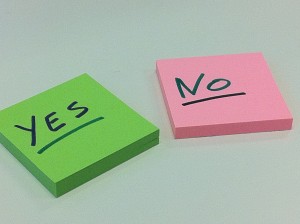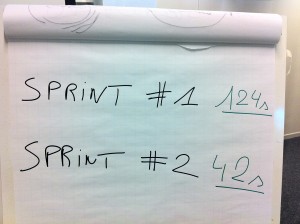[English version below « A Scrum Kickoff… »]

En général quand je démarre une mission « Agile », mon premier souci est de comprendre comment fonctionne la société. Comment les différents départements collaborent entre-eux.
Il y a quelques mois de cela, j’étais précisément à cette étape. J’avais rencontré 30 personnes des différents départements de la société. Et me voilà à me demander ce que je vais faire de toute ces informations et différents feedbacks.
Pour information, lors de cette étape je leur demandais d’expliquer leur job et comment ils contribuaient à la réalisation des projets. Je leur ai également demandé selon eux ce qui fonctionnait bien et les problèmes qu’ils rencontraient.
La Présentation
Pour transmettre mes résultats je n’avais que 2 heures de réunion prévue. Je voulais qu’ils aient une vue d’ensemble, je voulais que le groupe soit actif et enfin je voulais avoir l’opportunité de d’introduire Scrum. J’avais des slides sur Scrum que j’aurais pu réutiliser mais je voulais éviter une réunion du type « je parle, ils écoutent ». Et ce bien que ma maman m’ait maintes fois répété que j’avais une voix merveilleuse 😉
La première partie de la présentation consistait à discuter ce qui fonctionne bien dans la société et ce que l’on peut améliorer. Dans un tel exercice il est selon moi important de faire l’effort de découvrir aussi ce qui va bien. Car l’on veut capitaliser sur les bonnes pratiques…et non les abandonner. De plus une longue liste de choses « négatives » peut être immédiatement très démotivante. J’avais donc 4 slides: 2 avec les choses positives et 2 avec une liste d’améliorations possibles.
En résumé donc, je voulais que cette meeting soit:
- Un feedback sur ma période d’observation
- Une introduction à Scrum
Et je voulais que les participants:
- Soient actifs
- Vivent la méthode
Le Processus utilisé
J’ai démarré la réunion en donnant à un participant un paquet de post-it vert et un autre rouge. Ensuite je lui ai demandé d’en prendre un de chaque et de passer le paquet à son voisin. Dans cette phase j’ai été intentionnellement directif et je vérifiais secrètement le temps pour que chacun aie ses deux post-it. Le temps écoulé: 124 secondes.
Ensuite je leur ai demandé d’écrire « Oui » sur le post-it vert et « Non » sur le post-it rouge. Ensuite, j’ai commencé ma présentation. A chaque fois que j’annonçais un point positif, ou une piste d’amélioration, je leur demandais de voter pour voir s’ils étaient d’accord ou pas. Le vote se faisait en levant simultanément un seul post-it (Oui ou Non) par participant. Rendons à César ce qui appartient à César, j’avais vu cette manière de voter utilisée dans des conférences, notamment par Henrik Kniberg et Claude Aubry.
Les slides suivants de la présentation concernaient Agile et Scrum. Certains slides comportaient des provocations comme: “Agile est une méthode magique qui va régler tous mes problèmes ». Lors de ces slides je demandais également aux participants de voter. Ce genre de slides accompagné du système de vote a également amené d’intéressantes conversations.
A la fin de la présentation, je leur ai demandé si Scrum était clair pour eux. Ils m’ont répondu « Oui » et ensuite je leur ai annoncé qu’ils venaient d’effectuer un sprint…et que nous allions en démarrer un second immédiatement. Ils étaient quelque peu surpris.

Donc je leur ai expliqué que le premier sprint (la distribution des post-it) avait pris 124 secondes…Ce qui était bien entendu malhonnête de ma part vu qu’ils n’étaient pas au courant 🙂
Donc, je leur ai proposé un second sprint.
L’objectif, du sprint 2 était: “Réaliser la user story aussi vite que possible ». Et la user story était “En tant que présentateur, Je veux que chaque participant ait un post-it vert et un post-it rouge afin de leur permettre de voter ». Je leur ai laissé 5 minutes de préparation, en ensuite à leur « GO » je démarrais le chrono. A la fin du sprint, le résultat était: 42 secondes. Waouw ! Seulement un tiers du temps initial.
Il y a eu un évènement cocasse. Un participant était fier de me montrer qu’il avait 2 rouges et 2 verts m’annonçant qu’il avait été « le plus productif ». Malheureusement en tant que client le fait qu’il ait 2 rouges et deux verts ne me donnait aucune valeur ajoutée…
Cela a été une bonne occasion d’introduire le concept suivant: faites ce que le client vous a demandé puis arrêtez.
Donc ce simple processus utilisé m’a permis d’introduire aux participants ces différents concepts:
- auto-organization
- Le principe Scrum « inspect and adapt »
- Les user stories
- Les réstrospectives
- Travailler en équipe
- « faites ce que le client vous a demandé puis arrêtez »
Puissant non ? Qu’en pensez-vous ? Quelqu’un a-t-il déjà utilisé un processus similaire ?
Bye
Bruno.
A Scrum Kickoff…

Usually when I start an Agile « Mission » my first concern is to understand how the company works. How the different business departments collaborate together.
A few months ago I was just in this step. I met 30 people from all departments of the company. And so I was there with plenty of feedbacks wondering “How will I use these information”.
Basically I just asked them to explain me their job and how they contribute to a project within the company. I also asked them what works well and what are the main problems.
The Presentation
I wanted them to understand the big picture, and wished to do it in an active way with the opportunity to introduce Scrum. I already had plenty of usable Scrum slides, but wanted to avoid a “Me speaking, them listening” effect; even though my mom used to say I have a beautiful voice 😉
The first part of the presentation was to list what works well within the company, and what can be improved. For such exercise, it’s important to insist on what works well, because we still want to continue working that way right ?! Moreover, a long list of “negative” things can create immediate demotivation. So I had 4 slides: 2 with “Positive things” and 2 named “list of possible improvements”.
So to summarise I wanted this meeting to be:
- A feedback on the study period
- An introduction to Scrum
And I wanted the participants:
- To be active
- To live the method
The Process
I started the meeting by giving to one participant a bunch of green and red post-it notes. Then, I asked him to take one of each and pass them to his neighbor. I was intentionally very directive and I was (secretly) tracking the time they took to complete the procedure. It took them 124 seconds to have all the post-it notes distributed to the participants.
Secondly, I asked each of them to write ‘Yes’ on the green post-it and ‘No’ on the red post-it. Then, I began my presentation. Every time I would announce a positive thing, they were asked to vote if they agree. The same exercise was done with the ‘list of possible improvements’. The participants had to raise a ‘Yes’ or ‘No’ post-it to vote. I saw this technique used in conference by Henrik Kniberg and by Claude Aubry.
The next slides of my presentation aimed at Scrum topic. A few slides were thought provoking like: “Agile is a magic method and will solve all my problems”.
The vote + those kind of slides led to interesting discussions.
At the end of the presentation I asked them if Scrum was clear for them, and once they answered “Yes” I told them that they just did one sprint and that we will start the second sprint right away. They were a bit surprised 😉

So I explain them that the sprint 1 took 124 seconds which was unfair from me of course because they were not aware 😉
Therefore, I proposed them do a second sprint.
Objective of sprint 2 was: « “Perform as quickly as possible ». The user story to do as a team was: “As a presenter, I want each participant to have one green post it notes and one red so I can use it to have them vote”. They had 5 minutes of preparation, then they had to give me the “Go” to start implementation. At the end of this sprint, the result was : 42 seconds. Waouw ! Only one third of the original time.
One funny thing did happen, one participant proudly told me “Hey look I have 2 green and 2 red !”. He thought he had reached another objective. However, as a client, I had no added-value to have a participant with 2 greens and 2 reds.
It was a nice opportunity to introduce the “do just what your client asked then stop” concept.
So this simple process was for me the opportunity to introduce them to:
- self organization
- the « inspect and adapt » concept
- the user stories
- the restrospectives
- Working with 5-9 people teams
- the « do just what your client asked then stop » concept
Quite powerful isn’it ?
If you have any thought or any comment about this, feel free to write me or to leave a comment
Cheers
Bruno.
Ps: Billet écrit en écoutant cette chanson: Mixtapes – Hope is for People